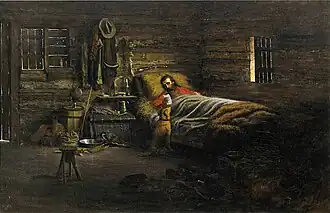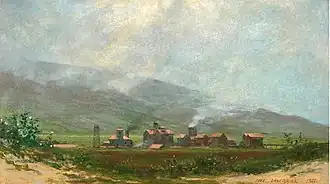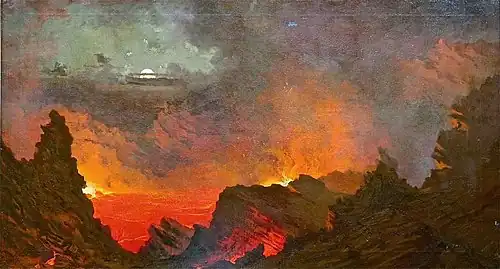Jules Tavernier (painter)
Jules Tavernier | |
|---|---|
 Undated photo, likely ca. 1877 or later. | |
| Born | 27 April 1844 Paris, France |
| Died | 18 May 1889 (aged 45) Honolulu, Hawaii |
| Nationality | French |
| Known for | Painting |
| Movement | Volcano School |
Jules Wilhelm Tavernier (27 April 1844 – 18 May 1889) was a French-American painter, draftsman, illustrator, and member of Hawaii’s Volcano School.
Life and career
Tavernier was born on 27 April 1844 in Paris to John Tavernier, an English confectioner from Plymouth, and his wife whom he married two years prior, Marie-Louise Rosalie Woillaume (born in Paris). Tavernier's parents and siblings would later move to England to join the English side of his family, but he chose to remain in Paris with his French relatives.
He studied with the French painter, Félix-Joseph Barrias, but left France in the 1870s, never to return.
Tavernier was employed as an illustrator by Harper's Magazine, which sent him, along with Paul Frenzeny, on a year-long coast-to-coast sketching tour in 1873.[1] He arrived in San Francisco in the summer of 1874, but soon traveled south and founded an art colony on the Monterey Peninsula.[2] In 1874, Tavernier came upon the tavern owned by his compatriot Jules Simoneau. Briefly, he established a studio at the Girandin Hotel (now called Stevenson House). In November 1875, Tavernier, alongside Walter Paris, leased space on Alvarado Street, establishing the first dedicated artist studio in Monterey. Tavernier's connection with Monterey led to his marriage to Lizzie Fulton in San Francisco in February 1877, whom he initially met in Monterey in 1876.[3]
Eventually, he continued westward to Hawaii, where he worked as a landscape painter. He was fascinated by Hawaii’s erupting volcanoes—a subject that was to pre-occupy him for the rest of his life, which was spent in Hawaii, Canada, and the western United States. Tavernier died from alcoholism on 18 May 1889 in Honolulu, Hawaii.[4]
Tavernier's students included D. Howard Hitchcock, Amédée Joullin, Charles Rollo Peters and Manuel Valencia.
Public collections holding paintings by Tavernier include the Brigham Young University Museum of Art (Provo, Utah), Colorado Springs Fine Arts Center (Colorado Springs, Colorado), Crocker Art Museum (Sacramento), Gilcrease Museum (Tulsa, Oklahoma), Hearst Art Gallery (Saint Mary's College of California, Moraga, California), Honolulu Museum of Art, Isaacs Art Center (Kamuela, Hawaii), Museum of Nebraska Art (Kearney, Nebraska), Oakland Museum of California, San Diego Museum of Art, Stark Museum of Art (Orange, Texas), Society of California Pioneers (San Francisco, California), Washington County Museum of Fine Arts (Hagerstown, Maryland), and Yosemite Museum (Yosemite National Park).
In 2014, the Crocker Art Museum in Sacramento, California, held an exhibition of more than 100 works by Tavernier, the first career retrospective of his work, accompanied by a catalog entitled Jules Tavernier: Artist & Adventurer. After the Crocker, the exhibition moved to the Monterey Museum of Art.[5][6]
From 16 August to 28 November 2021, the Metropolitan Museum of Art held an exhibition, Jules Tavernier and the Elem Pomo[7], that explored Tavernier’s cultural exchange with the Indigenous Pomo community of Elem at Clear Lake in Northern California[8] The show traveled to the de Young Museum[9], Fine Arts Museums of San Francisco from 18 December 2021 to 17 April 2022. The exhibit was the subject of the Metropolitan Museum of Art Bulletin.
Selected works
-
 A Balloon in Mid-Air, 1875, oil on canvas, Private collection
A Balloon in Mid-Air, 1875, oil on canvas, Private collection -
 The Pioneer, 1877, oil on canvas, Society of California Pioneers
The Pioneer, 1877, oil on canvas, Society of California Pioneers -
 White Man's Weapon, 1880, oil on canvas, Stark Museum of Art, Orange, Texas
White Man's Weapon, 1880, oil on canvas, Stark Museum of Art, Orange, Texas -
 Marin Sunset in Back of Petaluma, early 1880s, oil on canvas, Crocker Art Museum, Sacramento, California
Marin Sunset in Back of Petaluma, early 1880s, oil on canvas, Crocker Art Museum, Sacramento, California -
 Maui Sugar Plantation, 1885, oil on wood panel
Maui Sugar Plantation, 1885, oil on wood panel -
_-_'Wailuku_Falls%252C_Hilo'%252C_c._1886%252C_Pastel_on_paper.jpg) Wailuku Falls, Hilo, c. 1886, pastel on paper, Honolulu Museum of Art
Wailuku Falls, Hilo, c. 1886, pastel on paper, Honolulu Museum of Art -
 Sunrise Over Diamond Head, 1888, oil on canvas, Honolulu Museum of Art
Sunrise Over Diamond Head, 1888, oil on canvas, Honolulu Museum of Art -
 Kilauea by Moonlight, 1889, oil on canvas, Isaacs Art Center
Kilauea by Moonlight, 1889, oil on canvas, Isaacs Art Center -
_-_'Volcano_at_Night'%252C_ca._1880s%252C_oil_on_canvas%252C_19_x_36_in.jpg) Volcano at Night, late 1880s, oil on canvas, Honolulu Museum of Art
Volcano at Night, late 1880s, oil on canvas, Honolulu Museum of Art
References
- ^ Chalmers, Claudine, Scott A. Shields, and Alfred C. Harrison Jr. (2013). Jules Tavernier: Artist and Adventurer, Crocker Art Museum, Sacramento, California. ISBN 9780764966859
- ^ Crocker Art Museum, "Marin Sunset, Back of Petaluma" panel, Sacramento, California, n.d.
- ^ "New Book Fills In Some Old Blanks In Monterey's History" (PDF). Carmel-by-the-Sea, California: The Carmel Pine Cone. 10 November 2023. Retrieved 13 November 2023.
- ^ Shields, Scott A. (2006). "A New Eden: Jules Tavernier and the Beginning of Monterey's Art Colony". Artists at Continent’s End: The Monterey Peninsula Art Colony 1875-1907. University of California Press. pp. 11-37. ISBN 9780520247390. OCLC 920748853.
- ^ Christopher Reynolds (18 March 2014). "In Sacramento and Monterey, a pioneer painter gets his due". Los Angeles Times.
- ^ Victoria Dalkey (20 February 2014). "Art: Crocker exhibit devoted to works of Jules Tavernier". Sacramento Bee. Archived from the original on 18 March 2014.
- ^ "Jules Tavernier and the Elem Pomo - The Metropolitan Museum of Art". www.metmuseum.org. Retrieved 28 July 2025.
- ^ Kornhauser, Elizabeth; Vittoria, Shannon (1 November 2021). "Echoes of the Dance". Antiques. Retrieved 30 July 2025.
- ^ "Jules Tavernier and the Elem Pomo". FAMSF. Retrieved 28 July 2025.
Sources
- Forbes, David W., Encounters with Paradise: Views of Hawaii and its People, 1778-1941, Honolulu Academy of Arts, 1992, 95-209.
- Maier, Steven, Jules Tavernier: Hawaiʻi’s First Real Painter, Honolulu, Nov. 1996, 80.
- McGlynn, Betty Hoag, "Jules Tavernier, 1844-1889" in Tanner, Jerré E., Hawaii Island Artists and Friends of the Arts, premiere ed., Malama Arts Inc., Kailua-Kona, Hawaii, 1989, ISBN 0931909066, pp. 13–19